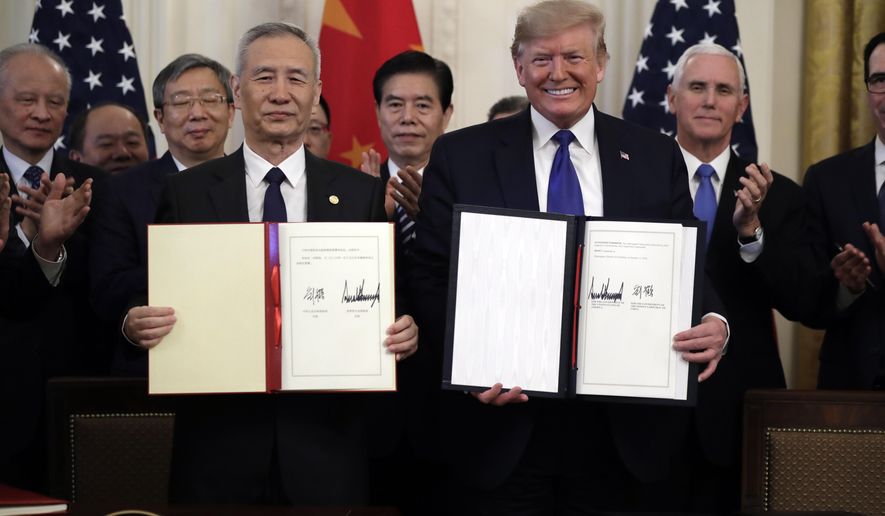OPINION:
President Trump’s Phase One trade deal may save the World Trade Organization from breakdown and takes international commerce to a better place in a world divided between democratic market and autocratic state-directed economies.
Free trade is a simple but compelling idea — at least at universities, where students are taught David Ricardo’s example of England and Portugal exchanging wine and cloth.
American export industries are more R&D-intensive and at least 10 percent more productive than import-competing industries. The United States exporting $2.5 trillion and importing a like amount would raise GDP by some $275 billion — if trade were balanced and workers displaced by imports found other work.
Also, bigger sales for U.S. technology-intensive activities finances more American R&D, product innovation and faster labor productivity growth — economists call these the dynamic gains from trade.
The WTO was set up by market-oriented Western economies to systematically reduce tariffs and other barriers to trade to encourage such benefits for all participating nations.
As tariffs came down, the world body increasingly focused on other policies that favor domestic goods and services over imports. For example, the inclination of government agencies to give preferences to local businesses in procurement, subsidies like those auto companies receive to build factories, and taxes like France’s and Italy’s levy on U.S. big-tech companies, which could advantage EU startups looking to horn in on Facebook, Amazon, Alphabet, Google and Netflix — as well as legacy techs like Microsoft.
When does a deal for Amazon to locate HQ2 in Arlington, Virginia, only affect domestic competition and when does it truly inhibit international commerce is hardly clear cut like the demonstrations of the lost economic gains from trade imposed by tariffs in Econ 101. Consequently, the major market economies established within the WTO a dispute settlement mechanism to arbitrate claims.
First, a panel of neutral trade experts — generally lawyers and other trade specialists — hear, for example, Boeing’s charge that Airbus gets benefits from the EU that compromise its sales. If those parties don’t like the panel’s findings, an appellate body reviews the case.
If all the players in the system are market economies it works well. The United States, my career studying these kinds of disputes indicates, usually gets a fair shake.
However, when China and similarly government-managed economies entered the system all that went out the window. China was permitted to join as a developing country and maintain higher tariffs than the United States, the EU, Canada and Japan. And it engages in opaque practices to manage its economy, limit imports and boost exports far beyond what Western governments could entertain.
The latter include various bureaucratic barriers to imports, subsidies to domestic production, forced technology transfers from foreign companies seeking to access Chinese markets and even state sponsored industrial espionage. And its participation in the dispute settlement process skewed the whole system away from disciplining market distorting practices of this kind.
This resulted in a huge U.S. trade deficit with China that steals jobs in many industries and stifles the benefits from free trade.
Mr. Trump, like Presidents Bush and Obama before him, spent his first year trying to persuade President Xi Jinping to open up China. However, these kinds of practices are central to maintaining state-owned enterprises and Chinese Communist Party guidance to private firms, which it considers essential to a successful socialist-market economy.
Mr. Trump resorted to two tactics. Blocking the appointment of new appellate judges at the WTO — the system now has too few to function — and imposing high tariffs on China to make it yield.
Mr. Xi refused to yield but to keep Mr. Trump from escalating, China agreed to increase purchases from the United States by $200 billion over two years and limited reforms, which should recoup some of the damage to the U.S. economy. And China accepts a separate bilateral process for Sino-American trade disputes.
Those are not pretty, but the alternative was to decouple from China altogether — for example, by imposing new restrictions on Chinese investment in the United States and financial sanctions. That would be a lot worse.
This deal provides a template for the EU and others to negotiate with China, and together Western nations can continue to settle their disputes through level one panels in the WTO.
Academic economists are no doubt apoplectic but trade diplomacy is about accepting what can be accomplished — not the perfection so easily obtained on classroom blackboards.
• Peter Morici, @pmorici1, is an economist and business professor at the University of Maryland, and a national columnist.




Please read our comment policy before commenting.